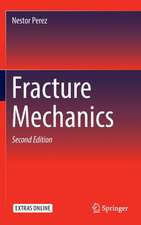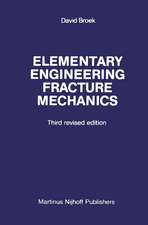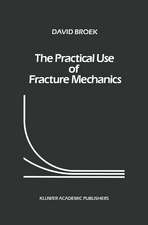Fatigue Damage, Crack Growth and Life Prediction
Autor F. Ellyinen Limba Engleză Hardback – 30 noi 1996
| Toate formatele și edițiile | Preț | Express |
|---|---|---|
| Paperback (1) | 1225.79 lei 6-8 săpt. | |
| SPRINGER NETHERLANDS – 15 sep 2011 | 1225.79 lei 6-8 săpt. | |
| Hardback (1) | 1232.26 lei 6-8 săpt. | |
| SPRINGER NETHERLANDS – 30 noi 1996 | 1232.26 lei 6-8 săpt. |
Preț: 1232.26 lei
Preț vechi: 1502.76 lei
-18% Nou
Puncte Express: 1848
Preț estimativ în valută:
235.82€ • 256.07$ • 198.09£
235.82€ • 256.07$ • 198.09£
Carte tipărită la comandă
Livrare economică 22 aprilie-06 mai
Preluare comenzi: 021 569.72.76
Specificații
ISBN-13: 9780412596001
ISBN-10: 0412596008
Pagini: 470
Ilustrații: XVI, 470 p.
Dimensiuni: 156 x 234 x 27 mm
Greutate: 0.86 kg
Ediția:1997
Editura: SPRINGER NETHERLANDS
Colecția Springer
Locul publicării:Dordrecht, Netherlands
ISBN-10: 0412596008
Pagini: 470
Ilustrații: XVI, 470 p.
Dimensiuni: 156 x 234 x 27 mm
Greutate: 0.86 kg
Ediția:1997
Editura: SPRINGER NETHERLANDS
Colecția Springer
Locul publicării:Dordrecht, Netherlands
Public țintă
ResearchCuprins
1 Some general concepts concerning fatigue.- 1.1 Introduction.- 1.2 Types of loading.- 1.3 Fatigue failure mechanisms.- 1.4 Factors affecting fatigue life.- 1.5 Fatigue design methodology.- 1.6 Probabilistic approach.- References.- 2 Cyclic stress-strain response.- 2.1 Introduction.- 2.2 Monotonic behaviour under tension or compression.- 2.3 Material response to cyclic deformation or loading — transient behaviour.- 2.4 Stable cyclic response.- 2.5 Analysis of hysteresis loops.- 2.6 Description of the master curve.- 2.7 Slope of the stress-strain curve during load reversal.- 2.8 Effect of temperature on the cyclic stress-strain relationship.- 2.9 Effect of environment on the stable cyclic stress-strain relationship.- 2.10 Effect of rate of loading on the stable cyclic response.- 2.11 Cyclic stress-strain relationship for multiaxial stress states — proportional loading paths.- References.- 3 Phenomenological approach to fatigue life prediction under uniaxial loading.- 3.1 Introduction.- 3.2 Stress-based approach.- 3.3 Strain-based approach.- 3.4 Energy-based approach.- 3.5 Cumulative damage.- 3.6 Time-dependent fatigue.- 3.7 A mechanism-based damage function for time-dependent fatigue.- 3.8 Effect of environment on crack initiation and fatigue life.- 3.9 Effect of mean stress and ratcheting strain on fatigue life.- References.- 4 Fatigue failure under multiaxial states of stress.- 4.1 Introduction.- 4.2 Previous investigations.- 4.3 A general approach to multiaxial fatigue.- 4.4 The multiaxial fatigue failure criterion.- 4.5 Multiaxial fatigue life prediction.- 4.6 Effect of mean-stress - proportional loading.- 4.7 Non-proportional cyclic loading.- 4.8 Effects of mean stress and ratcheting deformation.- References.- 5 Multiaxial experimental facilities.- 5.1Introduction.- 5.2 Specimen geometry.- 5.3 Analysis of thin-walled cylindrical specimens.- 5.4 The test system.- 5.5 Measuring devices.- 5.6 Test procedure.- 5.7 Typical multiaxial test results.- 5.8 Other test facilities.- References.- 6 Constitutive laws for transient and stable behaviour of inelastic solids.- 6.1 Introduction.- 6.2 Requirements for a constitutive model.- 6.3 Experimental definition of yield point and yield loci.- 6.4 Experimental observations.- 6.5 A constitutive model for transient non-proportional plasticity — rate-independent behaviour.- 6.6 Correlation with some experimental results.- 6.7 Extension to rate-dependent behaviour.- 6.8 Correlation with some rate-dependent experimental observations.- 6.9 A constitutive model for creep deformation including prior plastic strain effects.- 6.10 Concluding remarks.- References.- 7 Fatigue crack growth.- 7.1 Introduction.- 7.2 Linear elastic fracture mechanics.- 7.3 Nonlinear fracture mechanics.- 7.4 The concept of small-scale yielding.- 7.5 Initiation of crack growth.- 7.6 Mechanics of fatigue crack growth.- 7.7 A low-cycle fatigue-based crack propagation model.- 7.8 The crack closure phenomenon.- 7.9 Crack closure models.- 7.10 Time-dependent crack growth — temperature effects.- 7.11 Time-dependent crack growth — environmental effects.- References.- 8 Fatigue of notched members.- 8.1 Introduction.- 8.2 Notch analysis.- 8.3 Life to crack initiation.- 8.4 Growth of cracks initiated from notches.- 8.5 Initiation and growth of cracks from notches subject to far-field cyclic compressive load.- References.- 9 Growth and behaviour of small cracks.- 9.1 Introduction.- 9.2 Small crack regimes.- 9.3 Mechanisms of small crack growth.- 9.4 Experimental data on small crack behaviour.- 9.5 Models describingsmall crack behaviour.- References.- 10 Probabilistic fatigue crack growth.- 10.1 Introduction.- 10.2 Background.- 10.3 Experimental observations.- 10.4 A probabilistic crack growth model.- 10.5 Comparison with crack growth data.- 10.6 The effect of variable amplitude loading.- 10.7 A practical example.- References.









